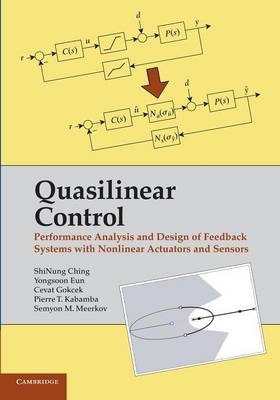
Quasilinear Control
Cambridge University Press (Verlag)
978-1-107-42938-3 (ISBN)
This is a textbook and reference for readers interested in quasilinear control (QLC). QLC is a set of methods for performance analysis and design of linear plant or nonlinear instrumentation (LPNI) systems. The approach of QLC is based on the method of stochastic linearization, which reduces the nonlinearities of actuators and sensors to quasilinear gains. Unlike the usual - Jacobian linearization - stochastic linearization is global. Using this approximation, QLC extends most of the linear control theory techniques to LPNI systems. A bisection algorithm for solving these equations is provided. In addition, QLC includes new problems, specific for the LPNI scenario. Examples include Instrumented LQR/LQG, in which the controller is designed simultaneously with the actuator and sensor, and partial and complete performance recovery, in which the degradation of linear performance is either contained by selecting the right instrumentation or completely eliminated by the controller boosting.
ShiNung Ching is a Postdoctoral Fellow at the Neurosciences Statistics Research Laboratory at MIT, where he has been since completing his Ph.D. in Electrical Engineering at the University of Michigan. His research involves a systems theoretic approach to anesthesia and neuroscience, looking to use mathematical techniques and engineering approaches - such as dynamical systems, modeling, signal processing and control theory - to offer new insights into the mechanisms of the brain. By combining physiology with technical tools, this 'systems neuroscience' approach to neurodynamics promises to suggest novel medical and pharmacological strategies and technologies. Yongsoon Eun received his BA degree in Mathematics, BS and MSE degrees in Control and Instrumentation Engineering, all from Seoul National University, Seoul, Korea, in 1992, 1994 and 1997, respectively, and his Ph.D. degree in Electrical Engineering and Computer Science from the University of Michigan in 2003. Since 2003 he has been with Xerox Innovation Group in Webster, New York, where he is currently a Senior Research Scientist. Dr Eun has worked on a number of subsystem technologies in the xerographic marking process, and recent activities focus on the image registration of inkjet marking technology. To date, he has published more than 30 journal and refereed conference papers and holds 4 US patents. His current research interests are control systems with nonlinear sensors and actuators, cyclic systems, and the impact of multitasking individuals on organizational productivity. Cevat Gokcek is a Professor of Mechanical Engineering at Michigan State University. His research in the Controls and Mechatronics Laboratory focus on automotive, aerospace and wireless applications, with current projects in plasma ignition systems and resonance-seeking control systems to improve combustion and fuel efficiency. Pierre T. Kabamba is a Professor of Aerospace Engineering at the University of Michigan. Professor Kabamba's research interests are in the areas of linear and nonlinear dynamic systems, robust control, guidance and navigation, and intelligent control. His recent research activities are aimed at the development of a quasilinear control theory that is applicable to linear plants with nonlinear sensors or actuators. He has also done work in the design, scheduling and operation of multi-spacecraft interferometric imaging systems, to be used to obtain images of exo-solar planets. Moreover, he has also done work in the analysis and optimization of random search algorithms. Finally, he is also doing work in simultaneous path planning and communication scheduling for UAVs under the constraint of radar avoidance. He is author or co-author of more than 170 publications in refereed journals and refereed conferences and of numerous book chapters. Semyon M. Meerkov has been a Professor of Electrical Engineering at the University of Michigan since 1984. He received his Ph.D. in Systems Science from the Institute of Control Sciences in Moscow, Russia, in 1966, where he remained until 1977. He then moved to the Department of Electrical and Computer Engineering at the Illinois Institute of Technology and subsequently to Michigan in 1984. He has held visiting positions at UCLA (1978–9); Stanford University (1991); Technion, Israel (1997–8 and 2008); and Tsinghua, China (2008). He was the editor-in-chief of Mathematical Problems in Engineering, department editor for Manufacturing Systems of IIE Transactions and associate editor of several other journals. His research interests are in systems and control with applications to production systems, communication networks and the theory of rational behavior. He is a Life Fellow of IEEE. He is the author or editor of numerous research publications and books, including Production Systems Engineering (with Jingshang Li) and Mathematical Problems in Engineering: Theory, Methods, and Applications.
1. Introduction; 2. Stochastic linearization of LPNI systems; 3. Analysis of reference tracking in LPNI systems; 4. Analysis of disturbance rejection in LPNI systems; 5. Design of reference tracking controllers for LPNI systems; 6. Design of disturbance rejection controllers for LPNI systems; 7. Performance recovery in LPNI systems; 8. Proofs.
| Zusatzinfo | Worked examples or Exercises; 6 Tables, unspecified; 154 Line drawings, unspecified |
|---|---|
| Verlagsort | Cambridge |
| Sprache | englisch |
| Maße | 178 x 254 mm |
| Gewicht | 530 g |
| Themenwelt | Technik ► Elektrotechnik / Energietechnik |
| Technik ► Maschinenbau | |
| ISBN-10 | 1-107-42938-2 / 1107429382 |
| ISBN-13 | 978-1-107-42938-3 / 9781107429383 |
| Zustand | Neuware |
| Haben Sie eine Frage zum Produkt? |
aus dem Bereich


